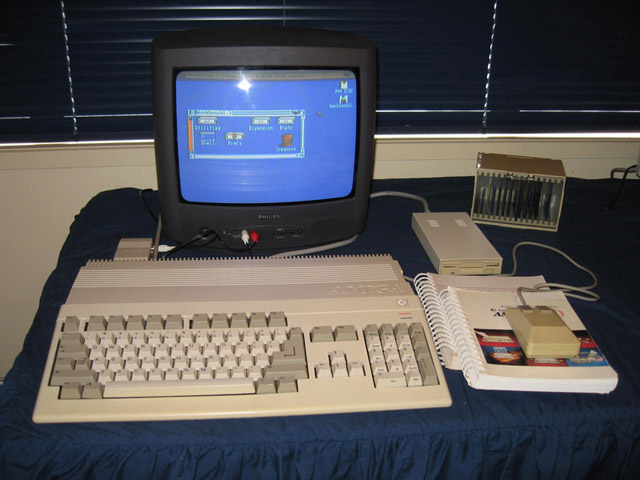| Tweet |
Making an Amiga boot disk (and getting other Amiga software) from disk images
Introduction
If you have found this page directly from an Internet search (as opposed to a link from my disk imaging introduction page) you have most likely missed some important information. Please click to READ THIS INTRODUCTORY PAGE FIRST. It explains some generic aspects of disk imaging and why, even if you DO have a good bootable disk, it may not work.

Figure 1. My Amiga 500 (before I got a proper Commodore monitor)
Hardware requirements
You'll need the following hardware:
- A Windows PC (any version)
- An Amiga. For the Amiga 500 an external floppy drive is also needed
- Blank 3.5 inch double density (not high density) disks in good condition
- A serial comms cable (null modem), or bluetooth serial adaptor or over TCP/IP
I had an Amiga 500 with an external drive, connected via serial cable to a PC running Windows XP.
Software
I found the shareware program Amiga Explorer to be just what I was looking for.
Like ADTPro with the Apple II, both computers need to be connected. There are quite a few steps so it's essential to follow the very clear documentation provided with the package. Basically to setup, you first install the Windows side of things which, when run for the first time, installs AExplorer on the Amiga. In my 500 this was initially installed in the RAM disk. After deleting a few non-essentials from my Workbench 1.3 disk like some fonts, printer drivers and notepad, I copied AExplorer from the RAM disk to the Workbench 1.3 disk as suggested in the setup directions.
Clicking the AExplorer icon turns the Amiga into a server, which is now under control of it's Windows client. Using Amiga Explorer on the Windows PC, I could view files and directories on the Amiga just as I could on my PC. Here's the nifty part though. Simply by dragging an ADF image file into the icon representing my external drive, I could write the image to any formatted disk there. Magic! The first thing I did was to make a fresh Workbench 1.3 disk to replace the copy that I had to remove files from to find room for AExplorer. The original (now "reduced") copy then became an AExplorer boot disk, to be used whenever I wanted to make new images.
There is more. On the Windows end, Amiga Explorer creates an ADF icon for each disk the Amiga is using. Dragging this to a folder on the PC machine will create an image file of the disk in question. Neat!
Amiga Explorer can be downloaded as a fully-functioning trial package. It's peanuts to buy, so registration is a must. It is sophisticated, intuitive software that works. Much of the initial setup is menu-driven, which helps enormously. Recommended!
By the way...
If you want to ditch the disk drive altogether and not worry about physical disks at all then consider an HxC floppy drive emulator or a Gotek (Google it).
Tez
Original article 23rd December, 2011. Updated 28th July, 2015
| Tweet |